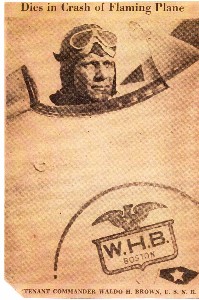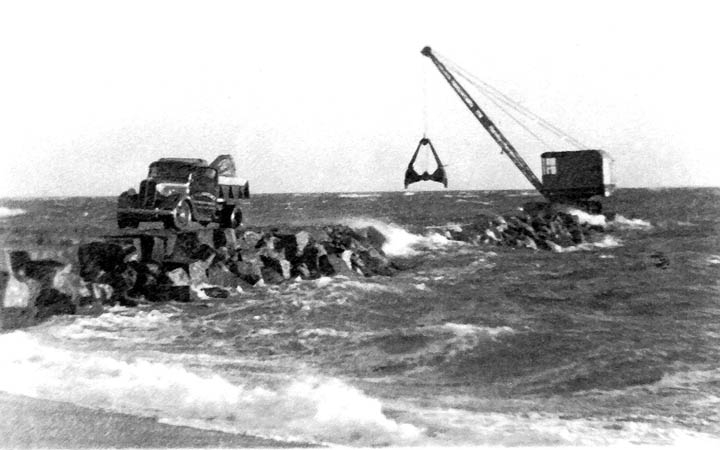Waldo Brown: The Man Behind The Wychmere Jetty Memorial
Veteran Navy Pilot And Mariner
by William F. Galvin
 HARWICH - (11/06/03) Nearly hidden away from the public's view along the Wychmere Harbor entrance channel jetty resides a memorial plaque honoring Waldo Brown, a man of major contribution to community and country.
Like the plaque itself, Brown receives little recognition in this community. Few knew him and fewer have had the opportunity to stumble upon the boulder that sits at the landward end of the jetty, connected to the seawall at the Snow Inn property and just south of the resort facility dock.
The memorial recognized the accomplishments of Waldo Brown “Founder of This Harbor of Refuge For Voyagers of the Sea and Air.” According to Harbormaster Thomas Leach, Brown is credited with the dredging improvements in Wychmere Harbor and for lobbying the FDR administration for the funds to create the Wychmere Outer Harbor breakwater.
HARWICH - (11/06/03) Nearly hidden away from the public's view along the Wychmere Harbor entrance channel jetty resides a memorial plaque honoring Waldo Brown, a man of major contribution to community and country.
Like the plaque itself, Brown receives little recognition in this community. Few knew him and fewer have had the opportunity to stumble upon the boulder that sits at the landward end of the jetty, connected to the seawall at the Snow Inn property and just south of the resort facility dock.
The memorial recognized the accomplishments of Waldo Brown “Founder of This Harbor of Refuge For Voyagers of the Sea and Air.” According to Harbormaster Thomas Leach, Brown is credited with the dredging improvements in Wychmere Harbor and for lobbying the FDR administration for the funds to create the Wychmere Outer Harbor breakwater.

But Brown, a naval pilot, should also be remembered as Veterans Day approaches for his service to this nation. He was one of the first 500 pilots commissioned and as a fledgling, approximately 21 years of age, was stationed at the Chatham Naval Air Station when a German submarine emerged off the coast of Orleans, shelling the community, during World War I.
Brown and two other pilots were sent from Chatham to attack the submarine, which had fired upon the tug Perth Amboy towing barges. While the bombs turned out to be duds, legend has it one of the pilots threw a wrench at the U-boat from 400 feet above. If nothing else, the presence of the planes sent the German submarine scurrying from Cape shores in what was the only attack on American soil in the war.
In honor of the pilots, a Detroit industrialist by the name of Gray, who had a summer home along Wychmere Harbor (the present day Steere property), invited the aviators to a party at his home. Brown met Frances M. Gray, the daughter of the wealthy industrialist, and at age 22, Brown married her.
A story in Yankee magazine several years ago defined Brown's life as comfortable, even through the hard times of the early 1930s. AThe family, lived, untouched by the Great Depression, in a world of mansions, society parties, chauffeured limousines, sailboats and private planes,” author E. B. Mills wrote.
Much of that time was spent along the shores of picturesque Wychmere Harbor where Brown was active in the Stone Horse Yacht Club. He also envisioned the need for a protective outer boat basin along the shoreline to draw beautiful pleasure craft and to provide a safe haven for fishing vessels.
In 1936, according to the Harwich Independent, Brown joined together with other civic-minded residents who soon agreed there were benefits to developing such a harbor, seeing it as one of the most important investments for the community.
He solicited the friendship and support of U.S. Army engineers and he even sold the idea to the Governor of the Commonwealth. Step by step he made progress and finally he received the recognition of Uncle Sam with an appropriation for nearly one half of the cost of the work, according to the local newspaper.
Then he explained the advantages of the project to Senator Nicholson at the State House and through his efforts in our behalf the Commonwealth appropriated the remainder of the $120,000 necessary to complete the work.
The Thanksgiving edition, Nov. 24, 1938, of the Harwich Independent went on to say: His success is now a matter of history. Harwich today, is viewing the splendid results of this public benefactor and his friend, and as we observe Thanksgiving Day, we should be grateful that the vision of Waldo Brown is now a pleasing reality.
Through his tireless and intelligent work and his ability to obtain the support of the right men in Washington and Massachusetts, Harwich can boast of a beautiful harbor among the best on the entire South shore. It did not cost Harwich one penny. It will bring her untold prosperity.
From all I have heard, Waldo Brown was a very capable, energetic and fine man, Wychmere Harbor resident George Rockwood told the Chronicle when providing research material on the navy pilot. Among many other activities, he was one of the friends of Stone Horse Yacht Club, of which he was commodore in 1937.
Waldo Brown's efforts on behalf of the community during the years leading up to World War II are still evident and appreciated by the boating public. But, with that project accomplished, Brown's services were needed elsewhere.
With the threat of war looming in Europe, the naval pilot returned to active duty as a flight instructor at Squantum Naval Air Station in South Weymouth. The naval pilot's son, John Brown of Chatham, told E. B. Mills his father had been assigned as a flight officer on the USS Wasp, an aircraft carrier soon to be launched from Fore River Shipyard in Quincy.
John Brown and his mother had been invited and were on the VIP platform on April 4, 1939, for the launching of the Wasp. Lieutenant Commander Waldo Brown was in the air at the time, conducting a flyover honoring the commissioning in a six-plane double echelon formation, according to Mills, when two of the planes clipped wings.
A local newspaper account stated, "Tragedy struck the Navy's gala launching of the Aircraft Carrier Wasp at Fore River Shipyard today when two naval planes crashed to earth causing the deaths of four aviators from Squantum Air Base".
The paper reported one eyewitness as saying, The ships were flying in close formation and as the dive began the wings of the two aircraft locked together. One plane went into a dive minus a wing.
The event happened just as Mrs. Charles Edison, wife of the assistant secretary of the Navy, had broken a bottle of champagne against the prow of the carrier. Brown bailed out, Mills reported, but too close to the ground.
His parachute failed to open. He hit and died instantly, according to Mills.

There were differing opinions on who was at fault in the accident, Brown, 46, or Ellsworth Benson, 26, the pilot of the other plane. Mills, a relation to Benson, wrote his piece for Yankee magazine looking for answers to that question and said there had been generations of finger-pointing among the families.
He cited portions of a summary account of the accident put together as a result of a Navy investigation which stated: AAfter a careful study and analysis of all the evidence and testimony, the board is unable to arrive at a positive finding as to the immediate cause of the collision or definitely place the responsibility for it.
After speaking at length with John Brown, one of Waldo's five children, Mills concluded in his story,I feel, as I had when we first met, that we are sort of long-lost relations. Together we have made a new Truth, not his, not mine, but ours, and it comforts us.
Last month, Harbormaster Thomas Leach got a letter from Ray and Betty Enos Frost of Beverly, inquiring about the memorial that keeps watch over the channel with the solitary endurance of a Lifesaving Service sentinel. Betty Enos is a cousin of Waldo Brown and has tried in the past to locate the memorial, but without luck. The Enoses made the trip from Beverly a few weeks ago and Leach guided them to Waldo Brown's memorial.
That memorial stands rock solid for a man who quietly made major contributions to his community and his nation.
11/06/03 Cape Cod Chronicle
 HARWICH - (11/06/03) Nearly hidden away from the public's view along the Wychmere Harbor entrance channel jetty resides a memorial plaque honoring Waldo Brown, a man of major contribution to community and country.
Like the plaque itself, Brown receives little recognition in this community. Few knew him and fewer have had the opportunity to stumble upon the boulder that sits at the landward end of the jetty, connected to the seawall at the Snow Inn property and just south of the resort facility dock.
The memorial recognized the accomplishments of Waldo Brown “Founder of This Harbor of Refuge For Voyagers of the Sea and Air.” According to Harbormaster Thomas Leach, Brown is credited with the dredging improvements in Wychmere Harbor and for lobbying the FDR administration for the funds to create the Wychmere Outer Harbor breakwater.
HARWICH - (11/06/03) Nearly hidden away from the public's view along the Wychmere Harbor entrance channel jetty resides a memorial plaque honoring Waldo Brown, a man of major contribution to community and country.
Like the plaque itself, Brown receives little recognition in this community. Few knew him and fewer have had the opportunity to stumble upon the boulder that sits at the landward end of the jetty, connected to the seawall at the Snow Inn property and just south of the resort facility dock.
The memorial recognized the accomplishments of Waldo Brown “Founder of This Harbor of Refuge For Voyagers of the Sea and Air.” According to Harbormaster Thomas Leach, Brown is credited with the dredging improvements in Wychmere Harbor and for lobbying the FDR administration for the funds to create the Wychmere Outer Harbor breakwater.

